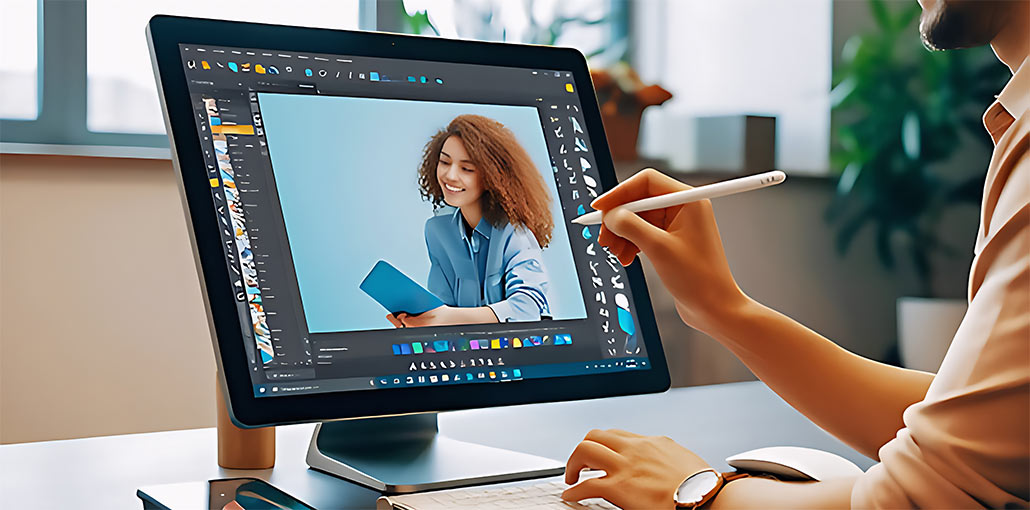In this digital age, photo editing software is more essential than ever. Modern cameras capture incredible levels of detail in photos captured and shared online. Tools that efficiently organize, edit, and share your work are necessary.
Our team evaluated several photo editing software programs and discovered that the best photo editing software makes it easy and accessible for both professional and enthusiast photographers. Adobe Lightroom Classic and Photoshop continue to lead this field by offering robust editing features suitable for professionals and enthusiasts.
10 Best Photo Editing Software in 2025
1. Adobe Photoshop
Adobe Photoshop remains the best photo editing software choice for professionals and businesses, offering unrivalled tools for photo correction, AI image generation, and graphic design. Thanks to its user-friendly layers interface with filters and typography support, it is an excellent tool for photographers and designers. Though subscription-only, this powerful editor offers features worth having for serious editing work.
Pros:
- Extensive suite of photo correction and manipulation tools
- Advanced generative AI capabilities
- Intuitive user interface with helpful guidance
- Tools for both mobile and web design
- Robust drawing and typography features
- Excellent support for raw camera files
- Cloud Documents, collaboration tools, and synced libraries
Cons:
- No option for a perpetual license
- Many processes run in the background, which may impact performance
Also read: Top 10 AI Video Editing Tools to Create Great Content Easily
2. Adobe Lightroom Classic
Lightroom Classic is the best photo editing software for professional photographers. It is a great tool for managing and importing your photo collection, and also includes top tools for correcting and enhancing photos in the raw file process. Lightroom Classic includes features not included in the non-Classic version of Lightroom, including printing, soft-proofing, tethered camera, and plug-in integration.
Pros:
- Powerful photo management and organization tools
- Automatic masking for precise local adjustments
- Face recognition and geo-tagging features
- Support for third-party plug-ins
- Fully capable mobile apps
Cons:
- Syncing photos to cloud storage can be complicated
3. Adobe Lightroom
Lightroom offers the same editing power as Classic but with seamless cloud storage and cross-device syncing. This best photo editing software features AI-driven tools, presets, and community learning. It’s simple, modern, and easy for beginners to learn. However, local printing and plug-in support are limited. It’s a good photo editing software for photographers who want editing on the go.
Pros:
- Simple and easy-to-navigate interface
- Reliable cloud photo syncing
- Color, detail, and lighting adjustments on par with Lightroom Classic
- Advanced raw profiles and AI-powered editing tools
- Strong community engagement and sharing features
Cons:
- Available only through subscription
- Lacks local printing and plug-in support
4. Adobe Photoshop Elements
Elements integrates many features from Photoshop into a user-friendly interface that focuses on guidance when creating effects. There are still layers, filters, and a smart Organizer application to manage your photo collection. The software doesn’t require subscription payments, but it is only available for 3 years.
Pros:
- Wide range of powerful image manipulation tools
- Advanced face-tagging and geotagging capabilities
- Excellent export and output options
- Effective and accurate search functionality
- Helpful tutorials and guidance for advanced techniques
Cons:
- License limited to three years
- No chromatic aberration correction or lens geometry profiles
- Limited cloud storage for mobile and web syncing
5. DxO PhotoLab
DxO PhotoLab offers superb RAW editing and the best photo editing software for noise reduction. It provides deep lens correction, geometry fixes, and advanced local adjustments. The SmartLighting and ClearView tools improve clarity automatically. Though it lacks major file format support, its DeepPrime XD2 engine delivers stunning quality, making it one of the most precise editors available.
Pros:
- Industry-leading noise reduction
- Clean and intuitive interface
- Excellent camera and lens correction tools
- Advanced geometry correction features
- Powerful and precise local adjustments
- Works without requiring photo import
Cons:
- Limited photo organization and workflow tools
- No support for AVIF, HDR, HEIF, or JXL formats
6. Corel PaintShop Pro
Corel PaintShop Pro delivers the best photo editing software at a lower price point. It supports layers, masks, vector drawing, and AI-powered effects. You get background replacement, style transfer, and portrait retouching—all without a subscription. While some operations are slow and macOS isn’t supported, PaintShop Pro remains a fantastic option for creative photo and graphic work.
Pros:
- Photoshop-like features at a lower price
- Powerful effects and image editing tools
- Extensive help resources and tutorials
- Solid selection of vector drawing tools
- Built-in automatic noise removal
Cons:
- Interface can be inconsistent at times
- No macOS version available
- Some features and operations can run slowly
7. Capture One
Capture One is the best photo editing software. It is the most effective way of interpreting a camera’s raw image data to produce a precise and sharp image among the applications we’ve tested. It also offers a wide range of local editing and adjustments tools, along with advanced color grading tools and layers. The distinctive Speed Edit feature accesses the most frequently used tools with a keypress. Capture One still trails Lightroom when it comes to certain workflow features, such as geotagging and face recognition.
Pros:
- Excellent raw file conversion quality
- Fast and efficient import speeds
- Automatic batch adjustment tools for quick editing
- Built-in collaboration features
Cons:
- Interface can be complex, especially when working with layers
- Lacks face recognition for photo organization
- Relatively expensive compared to competitors
8. CyberLink PhotoDirector
CyberLink creates one of the most advanced and creative video editing apps available, and the company has applied its deep image expertise to photo editing by integrating PhotoDirector. The program combines the organizational features of Lightroom and workflow tools, and layers that are similar to Photoshop, in an intuitive and clear interface.
The company is continuously creating new templates and effects, and has a plethora of creative AI editing and creation features now integrated into the program. The software is available as a one-time purchase or as a subscription that includes online storage and continuous up-to-date features and content. A subscription also grants access to stock photos from Getty.
Pros:
- Wide range of advanced effects and editing tools
- Comprehensive generative AI capabilities
- Unique Body Shaper feature for portrait enhancement
- Extensive support for layers and compositing
- Includes tethered shooting functionality
Cons:
- Interface can be complex and overwhelming
- Some operations may run slowly
Also read: Top 10 AI Image Enhancer & Upscaler Tools
9. Skylum Luminar Neo
Luminar Neo stands out with advanced AI tools and its user-friendly design, making it the best photo editing software for beginners. This best photo editor easily handles complex tasks such as sky replacement, relighting, and powerline removal. With its clean interface ensuring smooth editing, though larger files might slow things down somewhat. Perfect for creatives seeking effective results with minimal manual effort.
Pros:
- Unique AI-powered photo correction tools
- Clean and user-friendly interface
- Wide range of adjustment tools, effects, and filters
- Supports layers and masking for advanced editing
Cons:
- Some operations can be slow
- Lacks face recognition and keyword tagging features
10. Photopea
Photopea is a truly fully-featured Photoshop alternative, despite it being an entirely web-based photo editing software. Although you can access most of its features at no cost, the $5-per-month membership gives you the generative AI tools for creating images, additional actions in the editing history, and 5GB of online image storage.
Pros:
- Impressive range of Photoshop-like features
- Runs directly in the browser — no installation needed
- Clean, easy-to-use interface with helpful guidance
- Includes vector editing capabilities
Cons:
- Navigating away from the page can cause project loss
- Some actions may run slowly
- Missing certain advanced Photoshop tools and features
How to Choose the Best Photo Editing Software for You
- Identify Your Needs: Decide whether you need quick edits, creative effects, or professional-level tools for RAW images.
- Check Compatibility: Make sure the software runs smoothly on your device (Windows, macOS, or mobile).
- Look for Key Features: Prioritize essentials like layers, masking, AI tools, noise reduction, and lens corrections.
- Evaluate Ease of Use: Choose an interface that matches your skill level — simple for beginners, advanced for pros.
- Consider Organization Tools: If you manage many photos, look for tagging, face recognition, and cloud syncing.
- Review Pricing & Licensing: Compare one-time purchase vs subscription plans based on your budget.
- Test with Free Trials: Try before buying to ensure it fits your editing style and workflow.
- Plan for the Future: Pick software that can grow with your skills and support future upgrades or AI features.
Final takeaway
When you choose the best photo editing software, be sure that you download trial versions. It’s much easier to establish your decision after understanding the software in actual use. Select three photos and then edit them in each application. This allows you to evaluate the ease of use and features to discover whether you’ll feel confident using the program for the long term.
FAQs: Best Photo Editing Software
Which photo editing software is best for beginners?
Photoshop Elements and Luminar Neo are ideal for beginners, offering easy controls, guided edits, and powerful AI tools for fast results.
What’s the difference between Lightroom and Photoshop?
Lightroom is best for photo organization and color correction, while Photoshop excels at creative design, retouching, and advanced image editing.
Can AI photo editing software really improve image quality?
Yes, AI photo editing software like Luminar Neo and PhotoDirector can auto-enhance lighting, colors, and sharpness for stunning photo results.
Do I need a subscription for photo editing software?
Adobe Photoshop and Lightroom need subscriptions, but Corel PaintShop Pro and Luminar Neo offer one-time purchase options.
What features should I look for in photo editing software?
Look for AI tools, RAW support, masking, noise reduction, and lens correction for the best editing experience and workflow efficiency.










Leave a comment